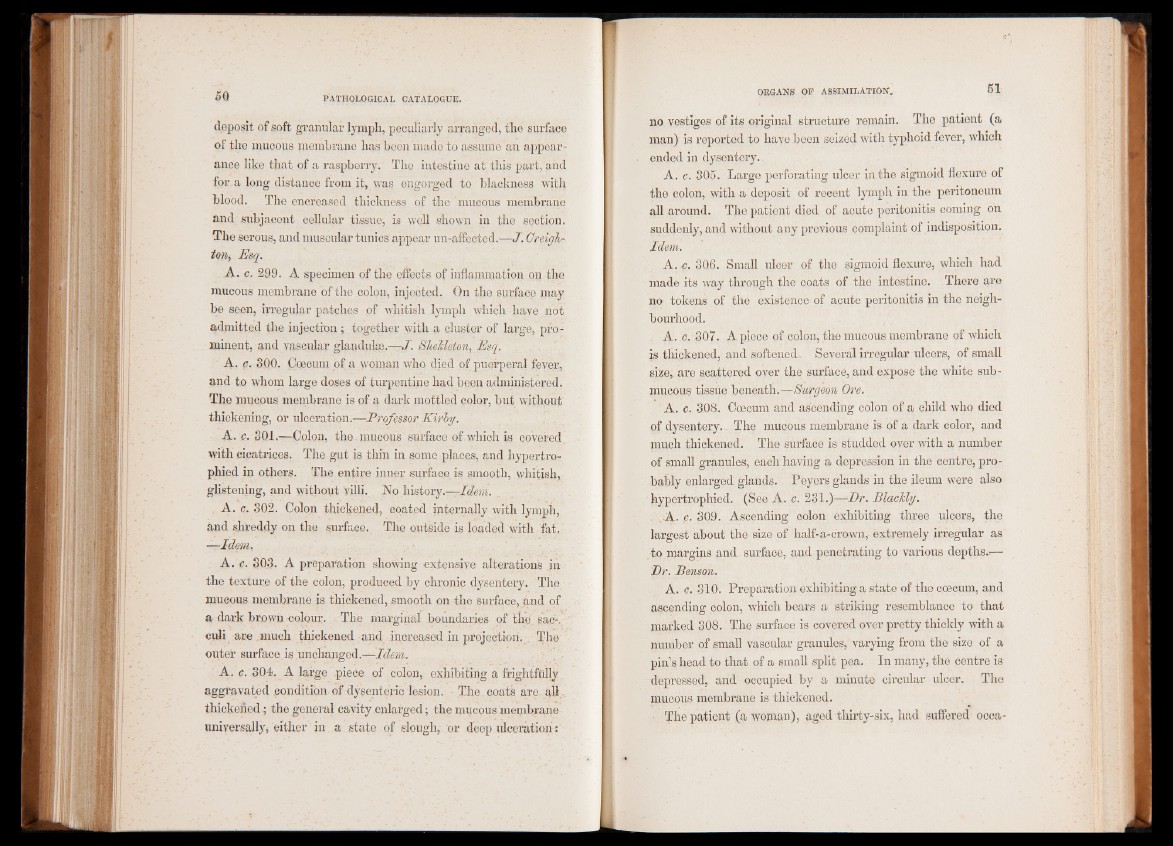
deposit of soft granular lymph, peculiarly arranged, the surface
of the mucous membrane has been made to assume an appearance
like that of a raspberry. The intestine at this part, and
for a long distance from it, was engorged to blackness with
blood. The encreased thickness of the mucous membrane
and subjacent cellular tissue, is well shown in the section.
The serous, and muscular tunics appear un-affected.—J. Creighton.,
Esq.
A. c. 299. A specimen of the effects of inflammation on the
mucous membrane of the colon, injected. On the surface may
be seen, irregular patches of whitish lymph which have not
admitted the injection ; together with a cluster of large, prominent,
and vascular glandulae.—-J. Shekleton, Esq.
A. c. 3Q0. Coecum of a woman who died of puerperal feyer,
and to whom large doses of turpentine had been administered.
The mucous membrane is of a dark mottled color, but without
thickening, or ulceration.—Professor Kirby.
A. c. 301.—Colon, the mucous surface of which is covered
with cicatrices. The gut is thin in some places, and hypertrophied
in others. The entire inner surface, is smooth, whitish,
glistening, and without villi. No history.—Idem.
, A. c. 302. Colon thickened, coated internally with lymph,
and shreddy on the surface. The outside is loaded with fat.
—Idem,
A. c. 303. A preparation showing extensive alterations in
the texture of the colon, produced by chronic dysentery. The
mucous membrane is thickened, smooth on the surface, and of
a dark brown colour. The marginal boundaries of the sac-,
culi are .much thickened and increased in projection. . The
outer surface is 'unchanged.-—Idem.
A. c. 301. A large .piece of colon, exhibiting a frightfully
aggravated condition.of dysenteric lesion. • The, coats are. all
thickened; the general cavity enlarged; the mucous membrane
universally, either in a state of slough, or deep ulceration :
no vestiges of its original structure remain. The patient (a
man) is reported to have been seized with typhoid fever, which
ended in dysentery.
A. c. 305. Large perforating ulcer in the sigmoid flexure of
the colon, with a deposit of recent lymph in the peritoneum
all around. The patient died of acute peritonitis coming on
suddenly, and without any previous complaint of indisposition.
Idem.
A. c. 306. Small ulcer of the sigmoid flexure, which had
made its way through the coats of the intestine. There are
no tokens of the existence of acute peritonitis in the neighbourhood.
A. o. 307. A piece of colon, the mucous membrane of which
is thickened, and softened. Several irregular ulcers, of small
size, are scattered over thé surface, and expose the white submucous
tissue beneath .^-Surgeon Ore.
A. c. 308. Cæcum and ascending colon of a.child who died
of dysentery. The mucous membrane is of a dark color, and
much thickened. The surface is studded over with a number
of small granules, each having a depression in the centre, probably
enlarged glands. Peyers glands in the ileum were also
hypertrophied. (See A. c. 231.);—Dr. Blackly.
. ,A. c. 309. Ascending colon exhibiting three ulcers, the
largest about the size of half-a-crown,- extremely irregular as
to margins and surface, and penetrating to various depths.:—
Dr. Benson.
A. c. 310. Preparation exhibiting a state of the cæcum, and
ascending colon, which bears a striking resemblance to that
marked 308. The surface is covered over pretty thickly with a
number of small vascular granules, varying from the size of a
pin’s head to that of a small split pea. In many, the centre is
depressed, and occupied by a minute circular ulcer. The
mucous membrane is thickened.
The patient (a woman), aged thirty-six, had suffered occa